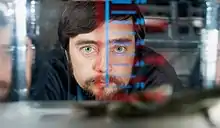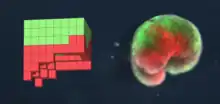Michael Levin (biologist)
Michael Levin is an American developmental and synthetic biologist at Tufts University, where he is the Vannevar Bush Distinguished Professor.[2] Levin is a director of the Allen Discovery Center at Tufts University and Tufts Center for Regenerative and Developmental Biology.[2] He is also co-director of the Institute for Computationally Designed Organisms [3] with Joshua Bongard. [4]
Michael Levin | |
|---|---|
 | |
| Born | 1969 |
| Citizenship | USA |
| Alma mater | Tufts University (BS) Harvard University (PhD)[1] |
| Known for | Xenobots, morphogenesis |
| Scientific career | |
| Fields | Developmental biology, synthetic biology |
| Institutions | Forsyth Institute[1] Tufts University[2] Wyss Institute Harvard Medical School |
| Doctoral advisor | Cliff Tabin |
| Website | http://www.drmichaellevin.org |
Early life
Michael Levin was born in Moscow, USSR, in 1969, in a Jewish family.[5] His parents faced antisemitism in the Soviet Union, and in 1978 took advantage of a visa program for Soviet Jews and moved the family to Lynn, Massachusetts.[5] Levin's father was a computer programmer and worked for the Soviet weather service;[5] his mother was a concert pianist.[6]
Levin's family immigration was sponsored by Temple Sinai in Marblehead, Massachusetts. His family is still members of Temple Sinai.[6] Levin stated that "... I've always lived within about a mile radius of where we landed in '78."[6]
Career
Levin received dual bachelor's degrees in computer science and biology from Tufts University, and a Ph. D. in genetics from Harvard University (working in the lab of Cliff Tabin[7]). His post-doctoral training was in the Cell Biology department of Harvard School of Medicine with Mark Mercola.[8] Levin first established his independent lab at the Forsyth Institute in 2000. His research interests include: bioelectrical signals by which cells communicate to serve the dynamic anatomical needs of the organism during development, regeneration, and cancer suppression; basal cognition and intelligence in diverse unconventional substrates; and top-down control of form and function across scales in biology. He moved his group to Tufts in 2009.[9] In 2010, he also became an associate member of the Wyss Institute of Harvard Medical School.[10]

He is known for co-discovering the Xenobots, "Living robots made from frog skin cells can sense their environment".[11] This research is focused on development of a multiplexed, microfluidic, Xenopus embryo culture system that will enable discovery of new drug targets and development of therapeutics when combined with multiomics and an integrated bioinformatics pipeline. This work was funded by the DARPA L2M program.
As of 2021, Levin's lab is working on synthetic biology applications of bioelectricity for cellular control; development of a bioinformatics of shape, AI tools for discovery and testing of algorithmic models linking molecular-genetic data to morphogenesis; using techniques from AI, computational neuroscience, and cognitive science to make models of morphogenesis.[12]
Levin is co-editor in chief of the Bioelectricity, founding associate editor of Collective Intelligence, and is on editorial advisory board of Laterality journals.[2]
Awards and honors
Source:[13]
- 2020 Distinguished Professor, Tufts University
- 2013 Distinguished Scholar Award, Tufts University
- 2013 Certificate of Teaching Excellence from MBL Stem Cell Course
- 2012 Scientist of Vision Award, IFESS
- 2011 Vannevar Bush Endowed Chair appointment
- 2004 The work on the molecular basis of left-right asymmetry (Cell 1995) was chosen by the journal Nature as a “Milestone in Developmental Biology in the last century”
- 2001 “Best Talk” award at the Juan March Foundation conference on Left Right Asymmetry in Madrid, Spain
- 2000 Junior Investigator Award, Society for Physical Regulation in Biology and Medicine
- 1997-2000 Helen Hay Whitney Foundation post-doctoral fellowship
- 1997 Alexander Imich Award, paper on cognitive science and consciousness
- 1992-1995 NSF pre-doctoral fellowship for Ph.D. work
- 1990, 1991 Hughes Scholarships for research in developmental biophysics
Publications
Michael Levin has published more than 350 papers; the full list can be found on his Google Scholar page[14] or in his official biography at Tufts website.[15][13] Some of the most cited papers:
- Levin, Michael; Johnson, Randy L; Sterna, Claudio D; Kuehn, Michael; Tabin, Cliff (September 1995). "A molecular pathway determining left-right asymmetry in chick embryogenesis". Cell. 82 (5): 803–814. doi:10.1016/0092-8674(95)90477-8.
- Levin, Michael (1 January 2005). "Left–right asymmetry in embryonic development: a comprehensive review". Mechanisms of Development. 122 (1): 3–25. doi:10.1016/j.mod.2004.08.006.
- Levin, Michael; Thorlin, Thorleif; Robinson, Kenneth R.; Nogi, Taisaku; Mercola, Mark (October 2002). "Asymmetries in H+/K+-ATPase and Cell Membrane Potentials Comprise a Very Early Step in Left-Right Patterning". Cell. 111 (1): 77–89. doi:10.1016/S0092-8674(02)00939-X.
- Sundelacruz, Sarah; Levin, Michael; Kaplan, David L. (September 2009). "Role of Membrane Potential in the Regulation of Cell Proliferation and Differentiation". Stem Cell Reviews and Reports. 5 (3): 231–246. doi:10.1007/s12015-009-9080-2.
- Blackiston, Douglas J.; McLaughlin, Kelly A.; Levin, Michael (November 2009). "Bioelectric controls of cell proliferation: Ion channels, membrane voltage and the cell cycle". Cell Cycle. 8 (21): 3527–3536. doi:10.4161/cc.8.21.9888. PMC 2862582.
- Levin, Michael (June 2007). "Large-scale biophysics: ion flows and regeneration". Trends in Cell Biology. 17 (6): 261–270. doi:10.1016/j.tcb.2007.04.007.
- Adams, Dany S.; Masi, Alessio; Levin, Michael (1 April 2007). "H+ pump-dependent changes in membrane voltage are an early mechanism necessary and sufficient to induce Xenopus tail regeneration" (PDF). Development. 134 (7): 1323–1335. doi:10.1242/dev.02812.
- Adams, Dany S.; Robinson, Kenneth R.; Fukumoto, Takahiro; Yuan, Shipeng; Albertson, R. Craig; Yelick, Pamela; Kuo, Lindsay; McSweeney, Megan; Levin, Michael (1 May 2006). "Early, H+-V-ATPase-dependent proton flux is necessary for consistent left-right patterning of non-mammalian vertebrates" (PDF). Development. 133 (9): 1657–1671. doi:10.1242/dev.02341. PMC 3136117.
- Fukumoto, Takahiro; Kema, Ido P.; Levin, Michael (May 2005). "Serotonin Signaling Is a Very Early Step in Patterning of the Left-Right Axis in Chick and Frog Embryos". Current Biology. 15 (9): 794–803. doi:10.1016/j.cub.2005.03.044.
- Levin, Michael; Pagan, Sylvia; Roberts, Drucilla J.; Cooke, Jonathan; Kuehn, Michael R.; Tabin, Clifford J. (September 1997). "Left/Right Patterning Signals and the Independent Regulation of Different Aspects ofSitusin the Chick Embryo". Developmental Biology. 189 (1): 57–67. doi:10.1006/dbio.1997.8662.
- Levin, Michael (December 2014). "Molecular bioelectricity: how endogenous voltage potentials control cell behavior and instruct pattern regulation in vivo". Molecular Biology of the Cell. 25 (24): 3835–3850. doi:10.1091/mbc.e13-12-0708. PMC 4244194.
References
- "Michael Levin Brief Bio". loop.frontiersin.org.
- "Tufts University: The Levin Lab". Retrieved 7 June 2021.
- "Institute for Computationally Designed Organisms". Retrieved 17 January 2022.
- "Josh_Bongard". Retrieved 17 January 2022.
- "Persuading the Body to Regenerate Its Limbs". The New Yorker.
- "Oral History Interviews with Michael Levin". American Institute of Physics.
- "Clifford_Tabin". Retrieved 17 January 2022.
- "Mark Mercola". Retrieved 17 January 2022.
- "Levin Lab". Tufts University: The Levin Lab. Retrieved 20 January 2022.
- "Wyss Institute: Michael Levin". Wyss Institute: Michael Levin. Retrieved 20 January 2022.
- "Living robots made from frog skin cells can sense their environment". New Scientist.
- "Levin's Lab: New directions". Retrieved 7 June 2021.
- "Michael Levin Biographical Sketch" (PDF).
- "Michael Levin GS". Google Scholar ML biologist. Retrieved 20 January 2022.
- "Levin's Lab Publications".
External links
- Computer-designed organisms - webpage about Xenobot research
- TuftsNow - Scientists Create the Next Generation of Living Robots
- Michael Levin's TED talk about Xenobots
- Quanta Magazine - Cells Form Into ‘Xenobots’ on Their Own
- NYTimes - Meet the Xenobots, Virtual Creatures Brought to Life
- The Biologist - ‘This is perhaps the first organism whose evolutionary history was in a computer’, interview with Michael Levin
- Wired - Cells Form Into Living ‘Xenobots’ on Their Own